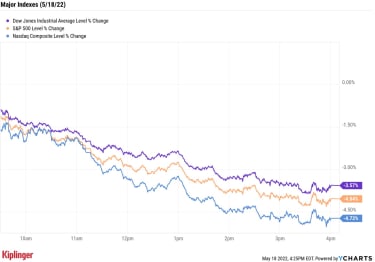Stock Market Today
The S&P 500 and Nasdaq each lost over 4% in a broad-market selloff.Retail earnings week took a big turn for the worse Wednesday.
A day after Walmart (WMT, -6.8%) sounded the alarm with a mixed quarterly report that suggested inflation was taking a toll on American consumers, Target (TGT, -24.9%) confirmed those concerns with an equally problematic set of results. That in turn sparked a deep blood-letting across most consumer stocks and sent the Dow to its worst single-day decline since June 2020.
As we detailed in today’s free A Step Ahead newsletter, Target topped Wall Street’s expectations for quarterly revenues, but it missed profit estimates by a country mile and issued a disappointing full-year operating profit. While consumer spending remained strong, it shifted from more discretionary purchases to staples such as groceries, plus spending on items such as luggage hinted that consumers are preparing to shift their dollars toward experiences rather than goods. Meanwhile, TGT projected it could need to absorb roughly $1 billion in other inflation-related costs, such as higher fuel and diesel prices.
“The Charlie Brown shirt market continues, with big moves up and down seemingly every day,” says Ryan Detrick, chief market strategist for LPL Financial. “Worries over inflation and a hawkish Fed are nothing new, but now add in worries over profit margins and the impact of inflation on the consumer, and you have the recipe for a big down day.”
A big down day indeed.
Sign up for Kiplinger’s FREE Investing Weekly e-letter for stock, ETF and mutual fund recommendations, and other investing advice.
Consumer-oriented sectors took Target’s news the worst. Consumer discretionaries (-6.6%) led the market lower, but typically defensive consumer staples (-6.4%) weren’t much better, with other stores such as Dollar General (DG, -11.1%) and Costco (COST, -12.5%) swooning in sympathy with TGT.
As far as the broader indexes were concerned? The Dow Jones Industrial Average plunged 3.6% to 31,490 – its worst single-session loss since a 6.9% decline on June 11, 2020. The S&P 500 Index was even worse, off 4% to 3,923 as all 11 of its sectors closed in the red. And the Nasdaq Composite suffered a 4.7% drop to 11,418.
YCharts
Other news in the stock market today:
The small-cap Russell 2000 shed 3.6% to 1,774.U.S. crude oil futures sank 2.5% to settle at $109.59 per barrel.Gold futures edged nearly 0.2% lower to finish at $1,815.90 an ounce.Bitcoin fell 2.7% to $29,237.10. (Bitcoin trades 24 hours a day; prices reported here are as of 4 p.m.)TJX Companies (TJX) was a rare splash of green today, adding 7.1% after the TJ Maxx parent reported earnings. In its first quarter, TJX reported adjusted earnings of 68 cents per share, more than analysts were expecting. However, revenue of $11.4 billion fell short of Wall Street’s estimate.”TJX believes profitability will improve throughout 2023 which we also see as a reasonable assumption as inventory levels normalize across retailers and TJX returns to pre-pandemic margin levels,” says CFRA Research analyst Zachary Warring (Strong Buy). “Marmaxxx, the company’s largest division, boasted +3% gain in comp store sales while HomeGoods fell 7% in Q1. TJX continues to return capital to shareholders, repurchasing $600 million in shares in Q1 and $307 million in dividends.”The Best Stocks for a Bear MarketToday’s selloff brought the dreaded “B” word back into focus. Although bear markets are very unpleasant for investors to watch unfold, they are a fact of life when it comes to market cycles.
“There have been 17 bear (or near-bear markets) since World War II,” says Detrick. The average drop for the S&P 500 was nearly 30% and lasted nearly a full year, he adds. But history suggests those losses could accelerate should the U.S. economy enter a recession. Specifically, bear markets that coincided with recessions typically lasted 15 months and saw losses of 34% for the S&P 500.
The Nasdaq entered bear-market territory awhile back, but the S&P 500 has so far managed to avoid that fate. Bear markets are classified as a decline of 20% from the most recent high. Based on where the broad-market index finished Wednesday, it’s off just 18.2% from its Jan. 3 peak.
Although it can be scary for investors to put their money into the market at a time like this, there are stocks that tend to fare better than others in this type of environment. The best stocks for bear markets tend to be those that have a defensive business, a long history of dividend growth and relatively low volatility. Here, we’ve gathered 10 stocks that fit those criteria and get consensus Buy recommendations from industry analysts to boot. Check them out.
